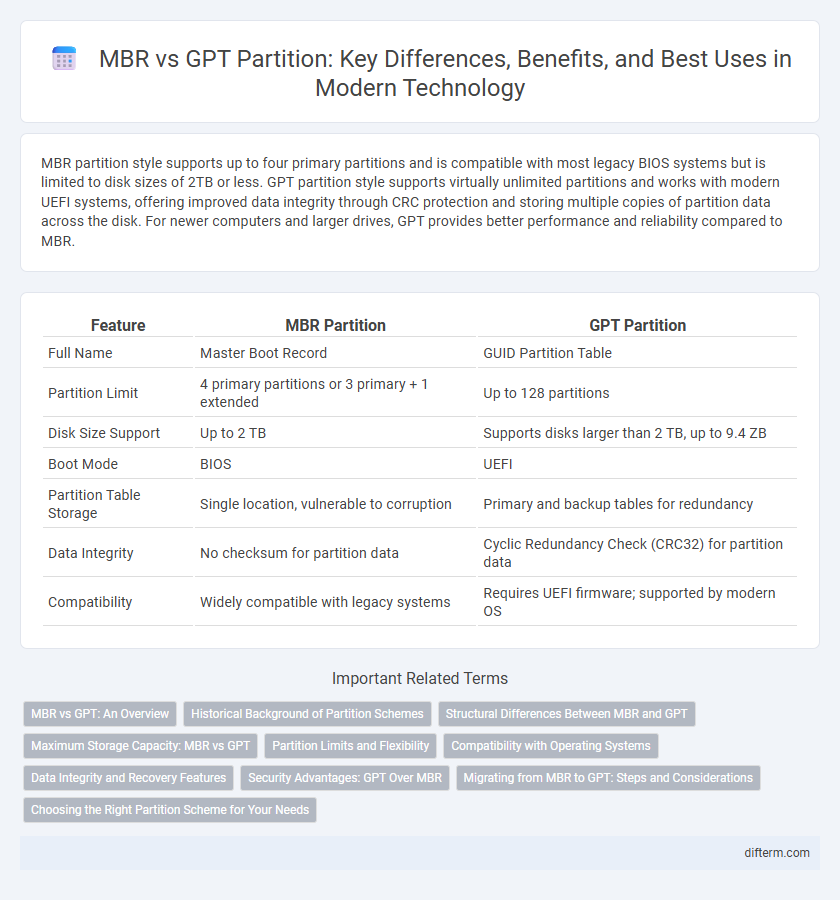MBR partition style supports up to four primary partitions and is compatible with most legacy BIOS systems but is limited to disk sizes of 2TB or less. GPT partition style supports virtually unlimited partitions and works with modern UEFI systems, offering improved data integrity through CRC protection and storing multiple copies of partition data across the disk. For newer computers and larger drives, GPT provides better performance and reliability compared to MBR.
Table of Comparison
| Feature | MBR Partition | GPT Partition |
|---|---|---|
| Full Name | Master Boot Record | GUID Partition Table |
| Partition Limit | 4 primary partitions or 3 primary + 1 extended | Up to 128 partitions |
| Disk Size Support | Up to 2 TB | Supports disks larger than 2 TB, up to 9.4 ZB |
| Boot Mode | BIOS | UEFI |
| Partition Table Storage | Single location, vulnerable to corruption | Primary and backup tables for redundancy |
| Data Integrity | No checksum for partition data | Cyclic Redundancy Check (CRC32) for partition data |
| Compatibility | Widely compatible with legacy systems | Requires UEFI firmware; supported by modern OS |
MBR vs GPT: An Overview
MBR (Master Boot Record) and GPT (GUID Partition Table) are two types of partitioning schemes used for managing disk partitions. MBR supports up to 4 primary partitions and disk sizes up to 2TB, while GPT allows for nearly unlimited partitions and supports disks larger than 2TB, using 64-bit addressing. GPT includes redundancy through a CRC-protected header and partition table, enhancing data integrity compared to MBR's single boot sector.
Historical Background of Partition Schemes
MBR (Master Boot Record) partitioning originated in the early 1980s with IBM PC DOS 2.0 and supported disk sizes up to 2 terabytes with four primary partitions. GPT (GUID Partition Table) emerged in the late 1990s as part of the Unified Extensible Firmware Interface (UEFI) standard, designed to overcome MBR limitations with support for disks larger than 2 terabytes and up to 128 partitions. The evolution from MBR to GPT marks a significant advancement in disk partitioning systems adapting to modern hardware and storage requirements.
Structural Differences Between MBR and GPT
MBR (Master Boot Record) partitions use a 32-bit partition table supporting up to four primary partitions with a maximum disk size of 2TB, relying on a single boot sector at the disk's start. GPT (GUID Partition Table) employs a 64-bit partition scheme allowing virtually unlimited partitions and supports disks larger than 2TB, using a primary and backup partition table for redundancy. GPT's structure includes a protective MBR, partition entries array, and CRC32 checksums ensuring data integrity and recovery capabilities absent in MBR.
Maximum Storage Capacity: MBR vs GPT
MBR partition supports a maximum storage capacity of 2 TB due to its 32-bit addressing limitation. GPT partition overcomes this constraint, allowing storage devices up to 9.4 ZB (zettabytes) with its 64-bit addressing. This substantial difference makes GPT ideal for modern large-capacity drives and advanced storage solutions.
Partition Limits and Flexibility
MBR partitioning supports up to four primary partitions or three primary partitions and one extended partition containing multiple logical drives, limiting total partitions to around 128 in most systems. GPT partitioning allows up to 128 partitions on a single disk without the need for extended or logical partitions, offering greater flexibility for organizing data. GPT also supports larger disk sizes beyond 2TB, overcoming MBR's size restrictions imposed by its 32-bit partition table entries.
Compatibility with Operating Systems
MBR (Master Boot Record) partitioning is widely supported by older operating systems such as Windows XP, Windows 7 32-bit, and legacy BIOS systems, making it suitable for compatibility with traditional setups. GPT (GUID Partition Table) is required for modern OSes like Windows 10/11 64-bit and macOS running on UEFI firmware, providing support for larger disks and more partitions. Most contemporary operating systems favor GPT for enhanced data integrity and booting capabilities, though legacy systems may not recognize GPT partitions.
Data Integrity and Recovery Features
GPT partitions offer enhanced data integrity through CRC32 checksums that detect and repair corrupted partition tables, while MBR partitions lack built-in error detection mechanisms. GPT also supports multiple copies of the partition table, improving recovery options in case of disk failure, whereas MBR relies on a single partition table, increasing risk of data loss. These advanced recovery features make GPT more reliable for modern storage devices requiring robust data protection.
Security Advantages: GPT Over MBR
GPT (GUID Partition Table) enhances security by storing multiple partition table copies across the disk, reducing the risk of data corruption compared to MBR's single partition table location. GPT also supports CRC32 checksums, enabling the detection of partition table errors and improving overall data integrity. These features make GPT a more robust and secure choice for modern storage devices.
Migrating from MBR to GPT: Steps and Considerations
Migrating from MBR to GPT requires backing up all important data due to partition format conversion risks, followed by using tools like Windows Disk Management or third-party software such as MiniTool Partition Wizard for conversion without data loss. Ensure the motherboard supports UEFI firmware because GPT is incompatible with legacy BIOS systems, which can affect bootability after migration. It's critical to verify disk alignment and partition integrity post-migration to optimize performance and prevent system errors.
Choosing the Right Partition Scheme for Your Needs
MBR partitions support up to four primary partitions with a maximum disk size of 2TB, making it suitable for older systems and legacy BIOS firmware. GPT partitions offer support for disks larger than 2TB and allow virtually unlimited partitions, providing enhanced data integrity through CRC protection and compatibility with UEFI firmware. Selecting the appropriate partition scheme depends on factors like disk size, motherboard firmware compatibility, and the need for advanced features such as secure boot and redundancy.
MBR partition vs GPT partition Infographic

 difterm.com
difterm.com